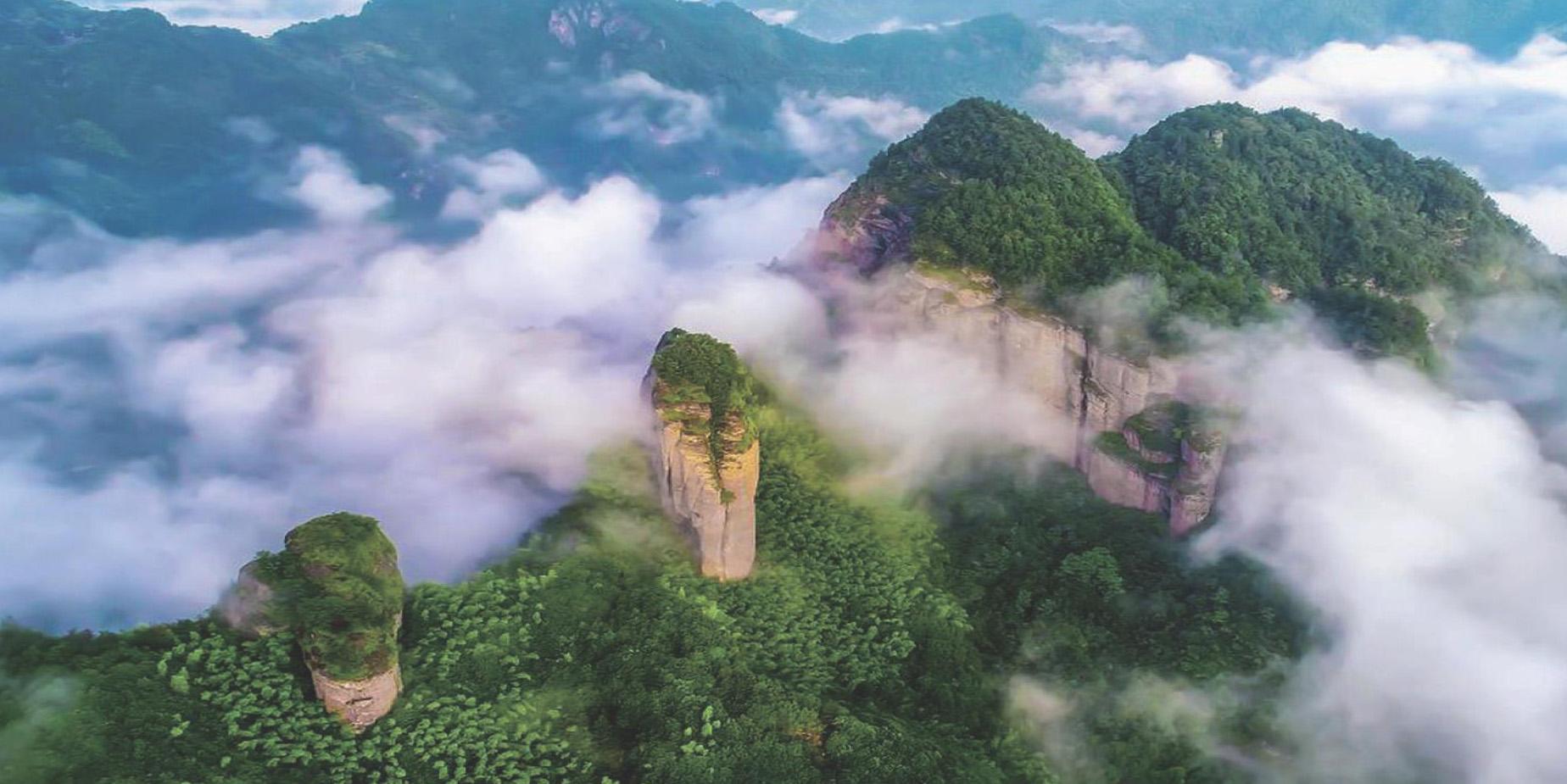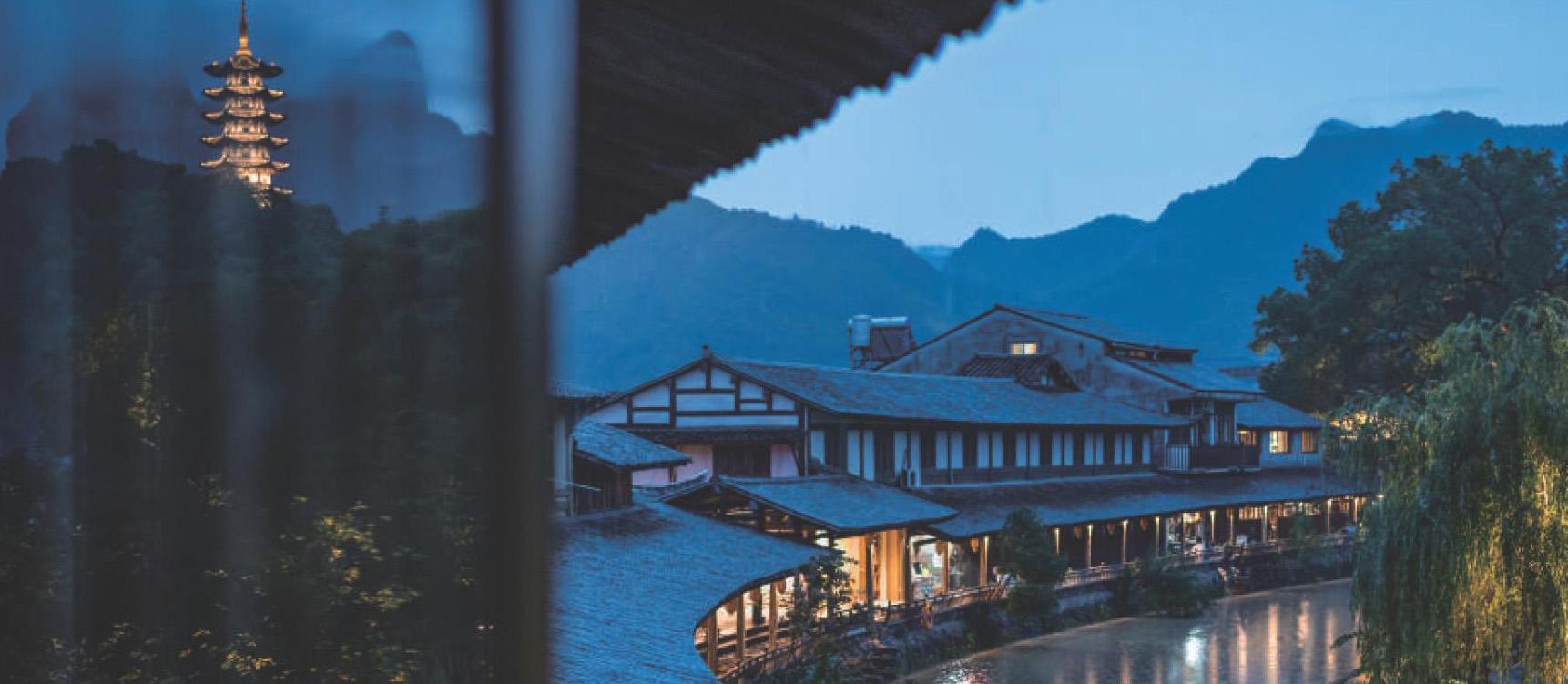瓯江山水诗路:浪漫而别致



“乱流趋正绝,孤屿媚中川。云日相辉映,空水共澄鲜。”这是谢灵运对江心屿水天交相辉映的生动描绘。诗与远方,就在瓯江山水之间,瓯江山水诗路作为古代浙南山水主游线,其承载的诗歌文化底蕴,独具浪漫而独特的诗意之美。
瓯江不仅是中国山水诗的发源地,更是一条维系温丽两地的黄金生命线。历史上,两地山水相依,文化同源,温润如玉的青瓷从这里出发,漂洋过海,成为古代海上丝绸之路炫目的文化交流使者。据不完全统计,瓯江沿线清朝以前的诗词共6300多首,分别是唐以前古诗25首、唐诗46首、宋诗439首、元曲13首、元明清诗5800多首,数以百计的诗人骚客,不辞辛劳,跋山涉水,寻觅着诗歌的不朽精魄。
山水诗发源地
一般认为“唐诗之路”渊源于东晋士族南渡,而“瓯江山水诗路”几乎同期起源。两者的开创,与谢灵运都有共同的文化渊源关系。
谢灵运(385年-433年),东晋陈郡阳夏(今河南太康)人,出生在会稽始宁(今浙江上虞),原为陈郡谢氏士族,著名山水诗人,主要创作活动在刘宋时代,中国文学史上山水诗派的开创者。由谢灵运始,山水诗乃成中国文学史上的一大流派,最著名的是《山居赋》,也是见诸史册的第一位大旅行家。
永初三年(422年),謝灵运放任永嘉太守。初到温州,谢灵运既作“池塘生春草,园柳变鸣禽”(《登池上楼》),“乱流趋正绝,孤屿媚中川。云日相辉映,空水共澄鲜”(《登江中孤屿》)名篇。
江心屿位于瓯江中游,是中国四大名胜孤屿之一,享有“中国诗之岛,世界古航标”之美誉。岛上东西双塔凌空,映衬江心寺,还有英领事馆旧址、宋文信国公祠、浩然楼、谢公亭、澄鲜阁等名胜古迹。
池上楼为纪念南朝著名诗人谢灵运所建,因其名篇《登池上楼》中“池塘生春草,园柳变鸣禽”传世,后人遂称该楼为“池上楼”。园内有假山、奇石、回廊,并有“青草轩”“怀谢楼”“十二梅花书屋”和“飞霞山馆”等。
其后,谢公足迹所及,除了郡城,还有瓯海、瑞安、平阳、永嘉、乐清等地,以及上溯 石门洞。谢公对永嘉楠溪江情有独钟,楠溪江素以“水美、岩奇、瀑多、林秀、村古”闻名遐迩,境内拥有芙蓉村、苍坡村、丽水街、龙瀑仙洞等景点。悠悠三百里楠溪江,被誉为“永远的山水诗,最美的桃花源。”谢灵运任永嘉太守期间,游历永嘉山水,留下大批描写楠溪江山水的诗篇。
“自言官长如灵运,能使江山似永嘉。”这是苏东坡的感叹。以中国山水诗鼻祖谢灵运发端,历代文人墨客皆青睐温州,杜甫、孟浩然、韩愈、沈括、徐霞客等,都为温州山水留下诗篇和墨迹。
亦是唐诗之路
如果说谢灵运的瓯江诗作让瓯江成了一条山水诗路,那么孟浩然等人的瓯江诗作则证明它也是一条唐诗之路。
孟浩然(689-740),字浩然,或名浩,以字行,今湖北襄阳市人,与王维一个“诗佛”,一个“诗星”,合称“王孟”,以其名诗“春眠不觉晓”为当今家喻户晓,早年曾与同乡世交、好友张子容一起隐居当地鹿门山,被称为“鹿门处士”。
唐开元年间,孟浩然到都城洛阳求取功名无成,心绪低落的他遂往山水秀丽的吴越地区游玩,像谢灵运一样借助山水诗创作来排遣失意心情。他写下《自洛之越》自述落魄心迹:“皇皇三十载,书剑两无成。山水寻吴越,风尘厌洛京……”
孟浩然有一位好友诗人崔国辅,在会稽郡(今绍兴)任山阴县尉(县尉职掌军事治安等)。重视友情的他忆起两人曾经有约,就动身前往相见,途中写下情深意重的《江上寄山阴崔国辅少府》。
而他的另一位老友张子容,中了进士后虽踏上仕途,此时却被贬职为乐成(今温州乐清市)县尉。落难的张子容在诗句里充满悲情地描述它夹在“穷海”与“恶溪”之间,“有时闻虎啸,无夜不猿啼”(《贬乐城尉日作》),俨然穷山恶水,野兽横行,且“炎瘴苦华年”(《永嘉作》),令他思乡不断。
当年冬天,阔别张子容十余年的孟浩然,专程去温州探望、慰劳好友。快到温州时,他以诗代信,写下《宿永嘉江,寄山阴崔国辅少府》,向入京的崔国辅汇报自己的旅程:我行穷水国,君使入京华。相去日千里,孤帆天一涯。卧闻海潮至,起视江月斜。借问同舟客,何时到永嘉?
孟浩然是亲历了温州山水的清秀,而著名诗人李白、杜甫,虽没来过温州,但都从谢诗中感受温州山水并充满景仰。如李白在《与周刚青溪玉镜潭宴别》中,开篇就写“康乐上官去,永嘉游石门。江亭有孤屿,千载迹犹存”;在《送王屋山人魏万还王屋》里也提到石门、孤屿、谢康乐等。而杜甫在《送裴二虬作尉永嘉》中,也有“孤屿亭何处?天涯水气中。故人官就此,绝境兴谁同。隐吏逢梅福,游山忆谢公”句。
继孟浩然张子容之后,唐代诗人顾况、魏万、张又新、方干、郭密之等唐代诗人也沿此水路来去温州,留下不少诗作。从瓯江山水诗路连接到唐诗之路,温州堪称源头。孟的温州之行,与张子容、魏万等人,将谢灵运的瓯江山水诗路走成了唐诗之路。
别致的繁荣景象
也正是因为兼具山水诗和唐诗之风,“瓯江山水诗路”被认为也是“浙东唐诗之路”南段的延伸以及浙西南以瓯江流域为主干的扩散。这种形成,有其特殊的区域和空间原因。
古人水陆两道兼行,从越州诸县过天台 、雁荡、大若岩,以江心屿为南端终点,郡城则以飞霞洞为代表;若以江心屿为起点,上溯瓯江,以石门洞为主要的节点,直至莲都附近的南明山。从丽水出发,则顺流而下,亦以江心屿为终点。
从区域空间看,江心屿处于瓯江的出海口,沟通浙西南与东海,又处于闽粤与江浙的南北海道航线交汇的枢纽位置。江心屿边上的温州港长期以来是浙南和闽东北最大的吐纳口,担负着浙南地区以及丽水、台州、福建、宁德地区部分县的内外贸易货物和旅客运输中转任务。因此,无论“瓯江山水诗路”还是“浙东唐诗之路”的空间描述,江心屿都不能忽略。
瓯江还是浙西南物资运输的主要水道。两宋时期温处两地瓯江水路交通开始走向鼎盛,“良材兴贩自处转温,以入于海者众。”上游一带所生产的木材、桐油,以及诸如漆器、酒、柑橘、茶叶等均顺流而下,行销各地,其中大宗货物运输以瓷器为主。元代龙泉窑青瓷大量外销,占据全世界主要瓷器市场,出现了“瓯江两岸瓷窑林立,烟火相望,江上运瓷船舶来往如织”的繁荣景象。
運输船经由括瓯水道沿路汇合景宁、青田、永嘉各地所出的青瓷产品抵达温州港,从温州港出发,途经洞头岛海域,入海转庆元(宁波)、泉州分销南亚、东北亚,远销地中海沿岸各国,成为温州“海上丝绸之路”的重要输出商品和文化交流使者。以瓷器运输为主的瓯江流域水上交通线,铺垫了瓯江诗路的航道基础。
瓯江沿岸风景如画,吸引了历代众多贤达名士,他们或任职,或行旅,或寓居,或居乡,留下了大量诗词佳作和摩崖题刻。处州摩崖带分布于仙都、南明山、三岩寺、石门洞、太鹤山等处,温州地区诗刻摩崖多在雁荡山、郡城的九山诸处,及至瑞安、仙岩以及南下平阳。题材有简单的记游题刻,更多的是山水诗词。据其题跋者身份所示,一类主要是官宦、文人,一类僧道。在人口流动管制的古代社会,这几种人有更多的机会远行。古代鲜有纯粹的为了写诗而写诗的采风旅游。
史书记载,谢在任“纵放为娱”,其实身为地方长官,公务巡察应是首务,谢灵运在温州的一年,足迹遍及各地。后人大多追随谢康乐的心迹,在仕途颠簸之中,触景生情,写下诸如“卧闻海潮至,起视江月斜。借问同舟客,何时到永嘉”之类的行旅诗。
僧道的山水诗更多禅意的洒脱,像担当和尚来游龙湫,句云:“君不见,柔沫牵来无断痕,我身欲化为冰魂。少焉辄欲生头角,一股倾湫还倒岳。不须霹雳能上天,聊在人间蜕个壳。”杜光庭著录天下洞天福地,俨然以大地为仙窟,以气息为车马,沟通天人。这是何等阔大的诗意啊。旅行者不同的身份、境遇、感触,书写了“瓯江山水诗路”丰富的题材。
情满瓯越大地
山清水秀,物产丰饶。瓯江山水诗路文化的底蕴潜移默化在影响着现代的东瓯大地。
在浙江八大水系中,温州就盘踞着瓯江、飞云江、鳌江三大水系,另外还有纵横市区的塘河水系,温州到处是“水清可游、岸绿可闲、街繁可贸、景美可赏”的江南水乡风光。同时拥有雁荡山、楠溪江、百丈漈三个国家级风景名胜区和乌岩岭、南麂岛两个国家级自然保护区。
灵运之后,历代诗人墨客慕名温州山水接踵而至,他们或徜徉瓯江口,或深入楠溪江、雁荡山等风景腹地,吟咏不绝。南北朝医药家、文学家陶弘景,唐代山水田园派诗人孟浩然,唐朝诗人、画家王维,唐末诗人、文学家、思想家罗隐,宋代女词人李清照,南宋文学家、史学家陆游,宋末政治家、文学家文天祥,以及当代诗人、散文家余光中,朦胧诗派的代表人物舒婷等,不胜枚举。
这些大家的创作,也在影响着温州本地的诗人们。温州历代诗人辈出,是中国有名的诗乡。著名的有:王十朋(1112-1171),南宋著名的政治家、诗人,温州江心寺楹联“云朝朝,朝朝朝,朝朝朝散;潮长长,长长长,长长长消。”即为他所题;叶适(1150-1223),南宋著名哲学家、文学家,“永嘉学派”的主要代表人物;林景熙(1242-1310年),南宋末期爱国诗人,诗文风格幽婉、沉郁,又不失豪放,共留下诗文16卷;现代诗人唐湜(1920-2005),九叶派诗人、诗评家,其长篇叙事诗和十四行诗在诗坛形成一个高峰。
“敢为天下先”的温州精神是海洋文化、山地文化等结合而成。温州当代有一批作家、学者在挖掘温州的山水文化,如作家许宗斌,叙写雁荡山文化,以山水与人为相结合,有《雁荡山笔记》行世。学者章方松足迹遍布温州山山水水,文章诠释温州山水文化的生命之根,有《大罗山笔记》问世。
建立在瓯江山水诗路文化底蕴上的“永嘉学派”也正在广泛影响着现代温州,温州也是中国首批14个沿海开放城市之一,浙南经济、文化、交通中心,改革开放以来,形成了“经世致用”为核心的“温州模式”,取得了较大发展。温州旅游业收入占全市GDP比重大,并且还在积极推进全域旅游,打造全景覆盖、全时体验、全业融合、全民共享旅游盛宴的成果。
对于温州,“瓯江山水诗”这一品牌,就像含苞欲放的花蕾,必将怒放于瓯江两岸,香飘在瓯越大地。
The Oujiang River Landscape Poetry Road: Romantic and Special
“Turbulence runs right across and the lone isle stands elegant in the river. The cloud and the sun reflect each other while the sky and the river share their freshness.” This is the sigh made by Xie Lingyun (385-433) over the reflection of the sky in the river at Jiangxin Isle. As the main tourist route of ancient southern Zhejiang landscape, the poetic cultural background contained by the Oujiang River Landscape Poetry Road has its own unique beauty and poetic endowment.
The Oujiang River is not only the origin of Chinas landscape poetry; it is more a golden lifeline that connects Wenzhou and Lishui. Historically, the two regions, geographically linked, shared an identical cultural origin. The translucent celadon started out from here across the seas to become a shiny cultural emissary on the Silk Road. According to rough estimates, along the Oujiang River, there are over 6,300 poems dating before the Qing dynasty (1616-1911), more specifically, 25 ancient poems from before Tang (618-907), 46 from Tang, 439 from Song (960-1279), 13 “qu” (air or aria) from Yuan (1271-1368), and over 5,800 poems from the Yuan, Ming (1368-1644) and Qing dynasties. Hundreds of poets climbed mountains and crossed streams to seek the immortal soul of poetry.
Tang poetry road is usually believed to have originated from literatis escape to southern China during the Eastern Jin dynasty (317-420), and the Oujiang River Landscape Poetry Road started at roughly the same time. The two roads were both culturally connected with Xie Lingyun.
Xie Lingyun, a native of Yangxia, Chenjun (present-day Taikang county, Henan province), was born in Shining, Kuaiji (present-day Shangyu district in Shaoxing city, Zhejiang province). He was the pioneer of the landscape poetry school in China's literary history, whose most famous poem is perhaps “Poem of the Mountain Residence”. He was also the first great tourist cited in history.
In 422, Xie Lingyun was appointed prefect of Yongjia, Wenzhou. When he first came to Wenzhou, Xie came up with such well-known lines as “Spring grass grows over the pond and birds chirp in the willows.” (“Ascending the Tower over the Pond”)
Jiangxin Isle is located in the midstream Oujiang River. It is one of the four major lone isles in China and enjoys the reputation of “the isle of Chinese poems and ancient beacon of the world.” On the isle two pagodas rise in the air from east to west to highlight the Jiangxin Temple. There are also sites of interest such as former site of the British Consulate, Ancestral Hall of Lord Wenxin of the Song Dynasty, Haoran Building, Pavilion of Lord Xie and Chengxian Pavilion.
The “Tower over the Pond” was built in memory of poet Xie Lingyun, made famous by his poem bearing the same name. In the garden there are rockeries, grotesque rocks and winding corridors, and buildings such as “Grass Pavilion”, “Pavilion in Memory of Xie”, “Study of 12 Plum Blossoms” and “Flying Cloud Mountain House”.
After that, Xies footprints covered, apart from the prefectural town, localities including Ouhai, Rui'an, Pingyang, Yongjia, Yueqing. Xie was especially fond of the Nanxi River in Yongjia, long known for its beautiful water, grotesque rocks, multiple waterfalls, elegant woods and ancient villages. Within the region there are such scenic spots as Hibiscus Village, Cangpo Village, Lishui Street and Longpu Fairy Cave. The 150km-long Nanxi River is reputed as “a forever landscape poem and the most beautiful peach blossom spring.” During Xie's tenure as prefect of Yongjia, he toured around the place, leaving behind a great number of poems describing the landscape of the Nanxi River.
“If I could serve as long as Xie Lingyun did in Yongjia, I could make my place as beautiful as Yongjia.” This was a sigh made by Su Dongpo. Starting from Xie Lingyun, the “founding father” of Chinas landscape poetry, men of letters of all ages showed their fondness for Wenzhou, and Du Fu (712-770), Meng Haoran (689-740), Han Yu (768-824), Shen Kuo (1031-1095), Xu Xiake (1587-1641) and so on left behind their poetry and calligraphy about the local landscape.
If Xie Lingyuns poems of Oujiang made the Oujiang River a poetry road of landscape, then poems of Oujiang written by Meng Haoran and so on proved it as a road of Tang poetry.
Meng Haoran was a native of todays Xiangyang city, Hubei province, famous for his “This spring morning in bed I'm lying, not to awake till the birds are crying”. He was called “Hermit of Lumen” in his early years as he used to retreat into the local Lumen Mountain together with his fellow countryman and friend Zhang Zirong (?-?).
In the heyday of the Tang dynasty, Meng Haoran went to the capital city of Luoyang for the imperial exam but failed. Low in spirits, he went to the scenic Wuyue region (mainly present-day Jiangsu and Zhejiang provinces) to tour like Xie Lingyue venting his frustration by way of writing landscape poems. He described his losing state of mind: “In as long as thirty years, I made achievements neither military nor literary. Seeking landscape in Wuyue, I am tired of the world in Luoyang.”
At the time, Cui Guofu (?-?), a close friend of Meng Haoran and also a poet, was the county commandant of Shanyin in Kuaiji prefecture (present-day Shaoxing city). Meng cherished their friendship so much that he started out from Luoyang to see him and wrote an emotional “To Chief Cui Guofu in Shanyin from the River”. Zhang Zirong, another old friend of his, though serving in the government after excelling in the imperial exam, was demoted to be the county commandant of Yuecheng (present-day Yueqing county, Wenzhou city) at that moment. The distressed Zhang Zirong sadly described in his poem that he was caught between a “poor sea” and an “evil creek”, “hearing tigers roar sometimes and apes whistle every night”. To Zhang, it was all barren hills and unruly rivers overrun with beasts, and “years plagued by malaria”, which made him homesick.
In that winter, Meng Haoran, who had not seen Zhang Zirong for over a decade, made a special visit to his good friend in Wenzhou. When he was about to reach Wenzhou, he wrote a poem “Staying on Yongjia River, to County Commandant Cui Guofu of Shanyin” as a letter to report his trip to Cui Guofu who had already gone to the capital: “I am travelling in a poor area, while you are on a mission to the capital. We are thousands of miles apart and a lone sail is wondering afar. When I sleep I hear the sea tide and when I rise I see the moon over the river. I'd ask my fellow travelers, when will I arrive in Yongjia?”
Meng Haoran did experience personally the pretty landscape of Wenzhou, but famous poets Li Bai and Du Fu, though never personally in Wenzhou, both “saw” the landscape of Wenzhou through Xie Lingyuns poems and were full of admiration. For example, Li Bai wrote “the high official goes to Xies Pavilion and tours the Stone Gate at Yongjia. At the river pavilion there is a lone isle, whose ruins stay after a thousand years”.
Because of its combination of landscape poetry and Tang poetry, the Oujiang River Landscape Poetry Road is regarded also to be the southern extension of the Tang Poetry Road in East Zhejiang and its expansion to southwest Zhejiang with the Oujiang River basin as the trunk. Such a formation has its special regional and spatial causes.
Ancient people travelled both on water and land from various counties of Yuezhou past Tiantai and Yandang Mountains, Daruoyan to Jiangxin Isle as its southern terminal. The prefecture town was represented by Feixia Cave. One started from Jiangxin Isle up the Oujiang River with the Stone Gate Cave as the main point all the way to Nanming Mountain near Liandu district in Lishui city. Starting from Lishui and travel downstream the Oujiang River they reached Jiangxin Isle as terminus.
With regard to regional space, Jiangxin Isle is located at the estuary of the Oujiang River connecting southwest Zhejiang and the East China Sea. It is also located in the hub position where the southern and northern navigation routes of Fujian, Guangdong, Jiangsu and Zhejiang meet. Wenzhou Port beside Jiangxin Isle has long been the largest cargo depot in southern Zhejiang and northeastern Fujian, bearing the transit mission of domestic and foreign trade cargo and passenger transportation in those areas. Therefore, in both the Oujiang River Landscape Poetry Road and Tang Poetry Road in East Zhejiang, Jiangxin Isle cannot be ignored.
The Oujiang River is also the main waterway of cargo transportation in southwestern Zhejiang. During the Song dynasties the waterway transportation of the Oujiang River started to prosper in that “good materials go from Wenzhou to the sea”. Wood and tung oil produced in the upper reaches and products such as lacquerware, wine, oranges and tea all went downstream to be sold elsewhere. The bulk cargo was mainly porcelain. In the Yuan dynasty, celadon of Longquan kiln was exported in large quantity to occupy the major porcelain markets of the world, leading to the prosperous sight of “kilns standing everywhere along the Oujiang River with fires burning here and there, and ships carrying porcelain were shuttling”.
The picturesque scene along the Oujiang River attracted celebrities of all generations. They took official positions, travelled, or lived there, leaving behind a large amount of good poems and cliff inscriptions.
Beautiful mountains and clear water yield rich produce. The cultural deposits of the Landscape Poetry Road silently influence the modern land of Dongou (Wenzhou and part of Taizhou). After Xie Lingyun, poets of later generations came to Wenzhou in succession. They strolled around the estuary of the Oujiang River, or deep into the hinterland of the Nanxi River and Yandang Mountain reciting poems. Among them are pharmacologist and litterateur Tao Hongjing (456-536) of the Southern and Northern dynasties, poet and painter Wang Wei (701-761) of the Tang dynasty, poet, litterateur and thinker Luo Yin (833-910) of the late Tang dynasty, woman poet Li Qingzhao (1084-1155) of the Song dynasty, litterateur and historian Lu You (1125-1210) of the Southern Song dynasty, statesman and litterateur Wen Tianxiang (1236-1283) of the late Sothern Song dynasty, and the contemporary poet and prose-writer Yu Guangzhong (1928-2017), etc.
The Wenzhou spirit of daring to be the first is a product of the combination between the marine culture and mountain culture. The Yongjia School established on the cultural deposits of Oujiang River Landscape Poetry Road is also widely influencing todays Wenzhou. Wenzhou is one of the first 14 coastal cities of China open to the outside world and the economic, cultural and communication center of southern Zhejiang. Since reform and opening up, the Wenzhou Model focusing on managing the world with pragmatism has gained remarkable progress. The revenue of the tourist industry of Wenzhou accounts for a large share in the citys GDP.
For Wenzhou, the Oujiang River Landscape Poetry Road is like a flower bud that is soon to bloom, destined to bring charm and fragrance to both banks of the Oujiang River.

